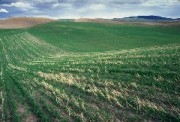| |
|
Soil is a dynamic and natural layer on the surface
of the earth composed of minerals, organic materials, and living
organisms in which plants grow.
Let's look at this definition and try to understand its meaning.
1. Soil is dynamic .... Meaning it
changes daily, hourly and even every minute. How does it do that? Well
soil is constantly changing its form and properties because of
microorganisms that live in it, water being added or removed, and by the
plant roots that are growing in the soils pores. These changes are
happening microscopically and are hard to see.
2. Soil is natural (made by nature
not humans) and takes up the first few inches to several feet on the
earth's surface.
 Soil
depth may go as deep as 40 feet or more before bedrock. Soil
depth may go as deep as 40 feet or more before bedrock.
3. What is soil composed or made
of? The weathering of rocks and other elements make the minerals in soil.
Weathering requires chemicals, wind and water which happens very slowly
over time.
4. Organic materials are plants and
other materials that have carbon which microorganisms use for food. This
is also a very slow process but much quicker than mineral decay described
in #3.
5.
 The
living forms are all the microorganisms, earthworms, insects and other
animals that live in the ground. A spoonful of soil may contain as many as
a million organisms like bacteria, fungi, insects, nematodes and protozoa.
Soil not only supports plant life but animal life as well. They all
contribute to the organic matter content of soil and are very important in
maintaining the quality of soils over long periods of time, which is very
important. Without good soil, our drinking water would become limited
along with food producing plants. Soil is the main filter for cleaning our
water supplies of contaminated material. The
living forms are all the microorganisms, earthworms, insects and other
animals that live in the ground. A spoonful of soil may contain as many as
a million organisms like bacteria, fungi, insects, nematodes and protozoa.
Soil not only supports plant life but animal life as well. They all
contribute to the organic matter content of soil and are very important in
maintaining the quality of soils over long periods of time, which is very
important. Without good soil, our drinking water would become limited
along with food producing plants. Soil is the main filter for cleaning our
water supplies of contaminated material.
Who is a Soil Scientist?
Simply put, a soil scientist is a person who studies soil. The job
of the soil scientist is to gather facts for solving problems or for
satisfying an interest about soil. To solve these problems the soil
scientist may work in the field, a greenhouse or a laboratory.

A soil scientist in his work clothes may resemble a farmer and may seem to
be doing similar work. The essential difference is the purpose of their
labor. The farmer grows crops to sell and make money. The soil scientist,
who does research on soil, is searching for information about the behavior
of the soil. He might try to solve practical problems or try to describe a
process that is happening to the soil. The average individual walking
through a field may see nothing but brown soil. A soil scientist walking
through the same field may observe many problems, some of which may
involve the success or failure of a crop. It is the combination of skill
in observation and an awareness that comes from training that enables the
soil scientist to recognize problems and use scientific methods to solve
those problems.
|
|



 |


